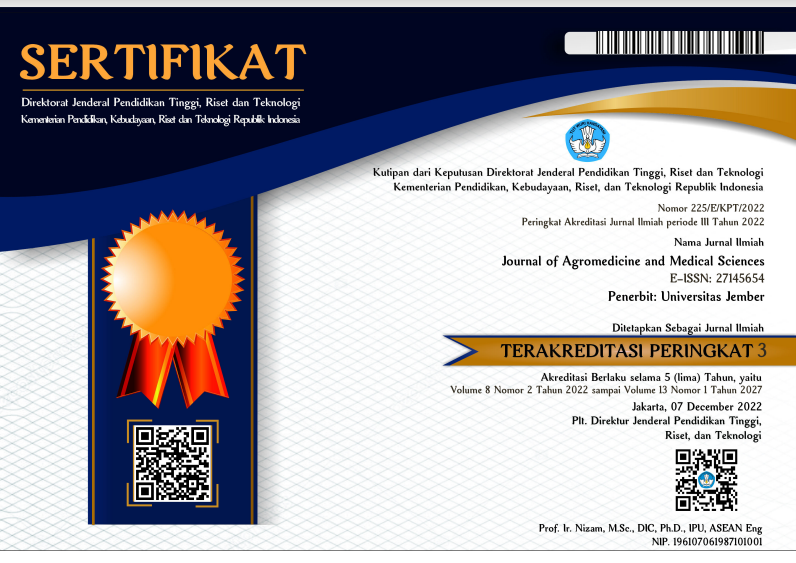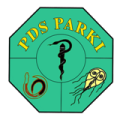The Correlation between Personal Hygiene of Greengrocer and Coliform Bacteria Contamination in Lettuce in Jember Traditional Markets
DOI:
https://doi.org/10.19184/ams.v8i2.30237Abstract
Lettuce is a vegetable that is usually consumed in raw condition or unprocessed by people. Unprocessed vegetables can cause food-borne diseases. Lettuce that is not processed and being consumed directly can cause contamination by Coliform bacteria. The purpose of this study is to know the correlation between Greengrocer’s personal hygiene and Coliform bacteria contamination in lettuce in Jembertraditional markets. This research used a descriptive observational design with the cross-sectional approach. It took place in eight traditional markets in Jember Regency and Microbiology Laboratory, Faculty of Medicine, University of Jember. The samples used were 41 lettuces purchased from 41 traditional market sellers. The microbiological examination was performed in the laboratory using the most probable number method. The results showed that lettuce sellers had bad personal hygiene (92,7%) and the data from the most probable number test found 97,6% contaminated by Coliform bacteria. The bivariate analysis was used to know the relationship between personal hygiene vegetable seller and contamination Coliform bacteria in lettuce. Thep-value was 0,072, which means there was no relationship between personal hygiene vegetable seller and contamination Coliform bacteria in lettuce.
Keywords: lettuce, Coliform, contamination, personal hygiene
Downloads
References
Abass, K., Owusu, A. F. S., & Gyasi, R. M. (2019). Market vegetable hygiene practices and health risk perceptions of vegetable sellers in urban Ghana. International Journal of Environmental Health Research, 29(2), 221–236. https://doi.org/10.1080/09603123.2018.1535057
Adrianto, R. (2018). Pemantauan Jumlah Bakteri Coliform di Perairan Sungai Provinsi Lampung. Majalah TEGI, 10(1), 1–6. https://doi.org/10.46559/tegi.v10i1.3920
Aini, R. Q., Sonjaya, Y., & Hana, M. N. (2010). Penerapan Bionutrien KPD pada Tanaman Selada Keriting (Lactuca sativa var. crispa). Sains Dan Teknologi Kimia, 1(1), 73–79.
Anwarudin, W., Suhendi, D., & Azizah, N. (2019). Analisis kualitatif bakteri coliform pada air bak penampungan umum desa taraju kabupaten kuningan. Farmasi, 4(1), 1–7.
Cossu, A., Dou, F., Young, G. M., & Nitin, N. (2017). Biomarkers of oxidative damage in bacteria for the assessment of sanitation efficacy in lettuce wash water. Applied Microbiology and Biotechnology, 101(13), 5365–5375. https://doi.org/10.1007/s00253-017-8314-5.
Efendi, R., & Syifa, J. N. A. (2019). Status Kesehatan Pasar Ditinjau Dari Aspek Sanitasi Dan Perilaku Hidup Bersih Sehat (PHBS) Pada Pasar Ciputat dan Pasar Modern BSD Kota Tangerang Selatan. Jurnal Kesehatan Indonesia, 9(3), 122. https://doi.org/10.33657/jurkessia.v9i3.179
Fauzi, R., Putra, E. T. S., & Ambarwayi, E. (2013). Pengayaan Oksigen di Zona Perakaran untuk Meningkatkan Pertumbuhan dan Hasil Selada (Lactuca sativa L.) Secara Hidroponik. Vegetalika, 2(4), 63–74. https://doi.org/10.22146/veg.4006
Herman, Napirah, M. R., & Sherlina. (2015). Faktor-faktor Perilaku Hidpu Bersih dan Sehat yang Berhubungan dengan Kejadian Food Borne Disease Pada Anak di Sekolah Dasar Negeri (SDN) Inpres 3 Tondo Kota Palu. Jurnal Kesehatan Tadulako, 1(2), 1–14.
Isro’in, L., & Andarmoyo, S. (2012). Personal Hygiene (Konsep, Proses, dan Aplikasi dalam Praktik Keperawatan). http://eprints.umpo.ac.id/2039/1/Buku_Personal Hygiene.pdf
Khaerunisa, M., & Cahyono, A. (2019). Hubungan Kebersihan Pribadi Pekerja Kantin Penyebab Kontaminasi Escherichia Coli Pada Makanan. Jurnal Kesehatan Masyarakat, 1(April), 1–7.
Krisnamurti, G. C. (2017). Penghitungan jumlah sel bakteri dengan Metode Most Probable Number (MPN). Prosiding Seminar Nasional Simbiosis II, September, 329–341. http://prosiding.unipma.ac.id/index.php/simbiosis/article/download/348/331.
Muna, F., & Khariri. (2020). Bakteri Patogen Penyebab Foodborne Diseases. Journal Uin Alauddin, 6(1), 74–79. http://journal.uin-alauddin.ac.id/index.php/psb/
Nuraya, A. D., & Nindya, T. S. (2017). Hubungan Praktik Personal Hygiene Pedagang Dengan Keberadaan Bakteri Escherichia Coli Dalam Jajanan Kue Lapis Di Pasar Kembang Kota Surabaya. Media Gizi Indonesia, 12(1), 7–13. https://doi.org/10.20473/mgi.v12i1.7-13
Olianovi, N., & Pasaribu, D. M. R. (2017). Menghitung Escherichia coli fekal dari air cucian selada di pasar wilayah Kecamatan Grogol. J. Kedokt Meditek, 23(61), 23–31.
Riana, A., & Sumarmi, S. (2018). Hubungan Kontaminasi Coliform dan Skor Perilaku Higiene Sanitasi pada Pedagang Jajanan di Kantin Sekolah dan Pedagang Keliling. Media Gizi Indonesia, 13, 27–32. https://doi.org/10.20473/mgi.v13i1.27.
Sari, R. K., Zulaikhah, S. T., & PH, L. (2019). Perbedaan Pengetahuan Perokok Aktif Dan Perokok Pasif Tentang Bahaya Rokok. Jurnal Ilmiah Permas: Jurnal Ilmiah STIKES Kendal, 9(2), 85–94. https://doi.org/10.32583/pskm.9.2.2019.85-94.
Silalahi, V., & Putri, R. M. (2017). Personal Hygiene Pada Anak SD Negeri Merjosari 3. Akses Pengabdian Indonesia, 2(2), 15–23.
Theopilus, Y., Yogasara, T., Theresia, C., & Octavia, J. R. (2020). Analisis Risiko Produk Alat Pelindung Diri (APD) Pencegah Penularan COVID-19 untuk Pekerja Informal di Indonesia. Jurnal Rekayasa Sistem Industri, 9(2), 115–134. https://doi.org/10.26593/jrsi.v9i2.4002.115-134.























